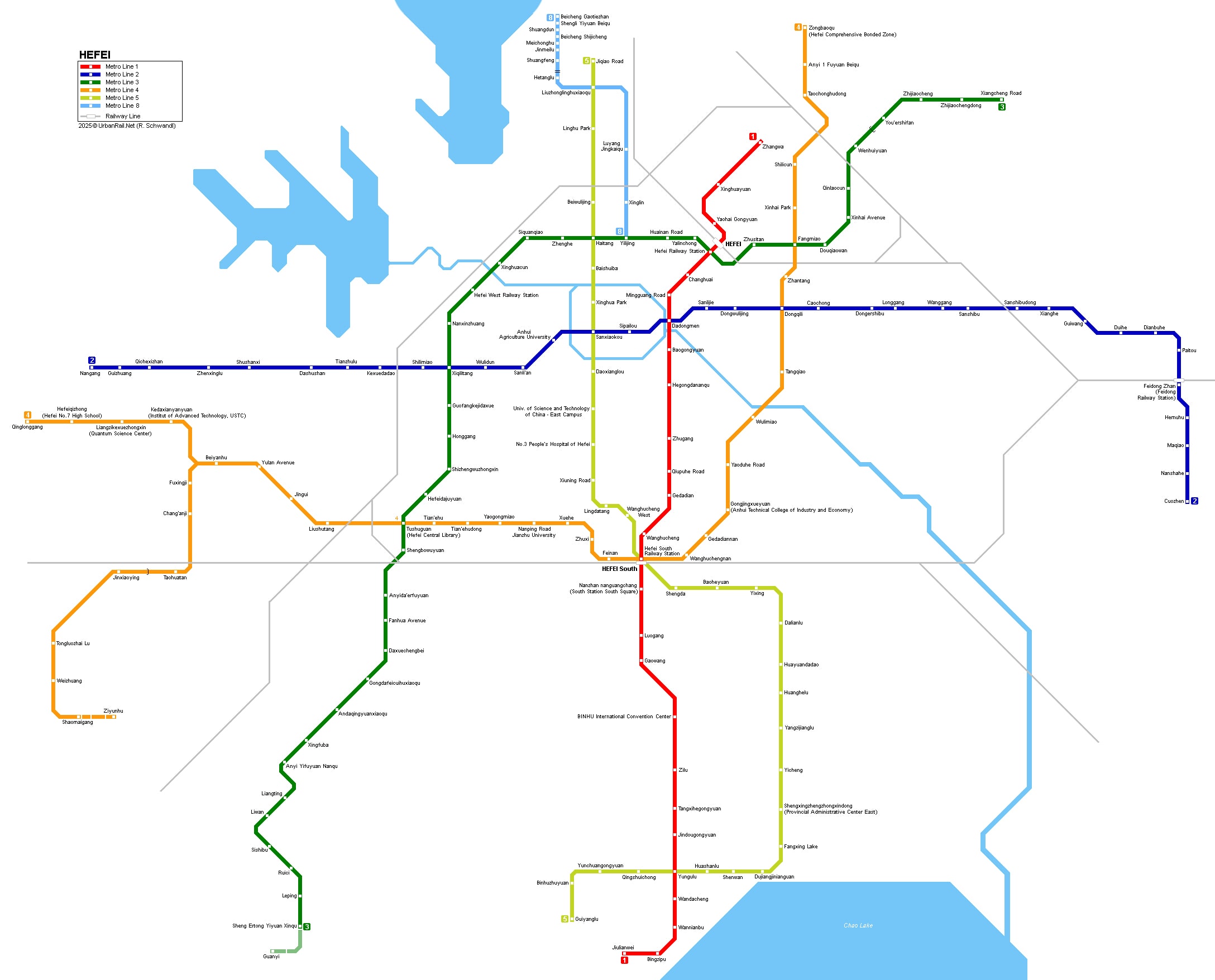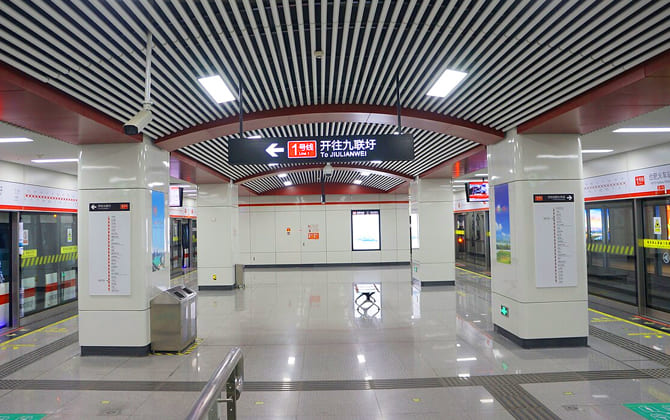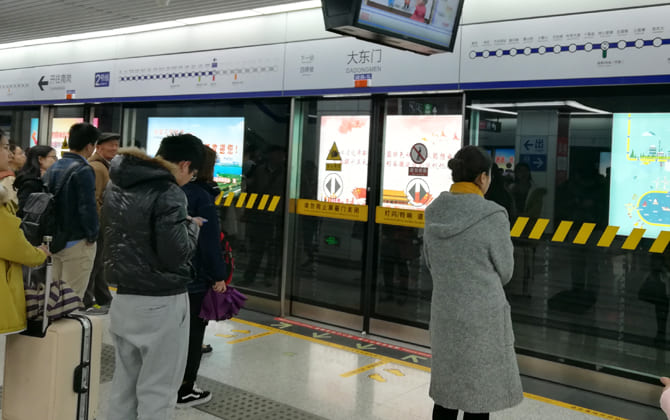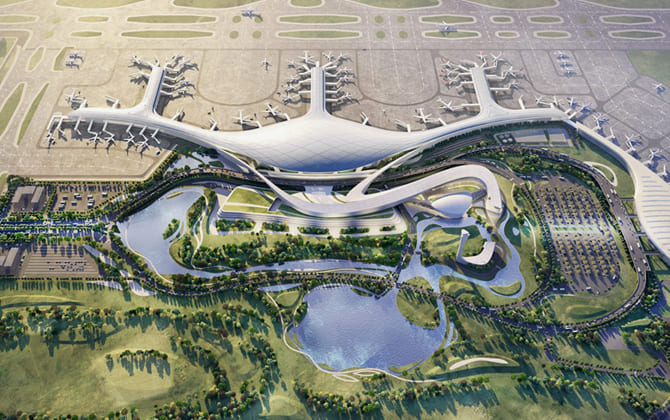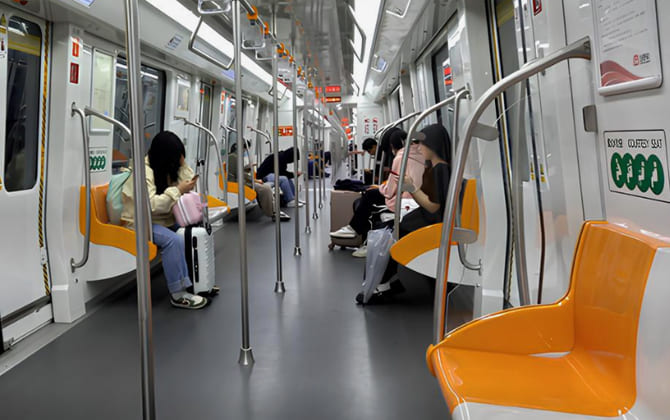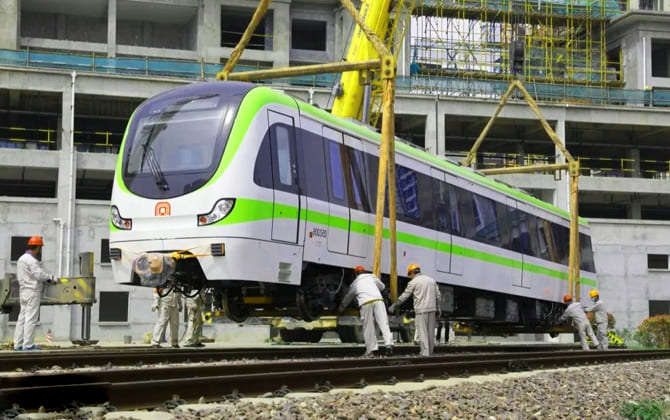Hefei Metro (合肥轨道交通) is a rapid-transit network in Hefei, the capital of Anhui Province, China. Since opening in late 2016, it has grown quickly. As of 2026, the system has 6 lines covering 232 km (144 mi) and 171 stations. On an average day, over 1.4 million passengers ride the metro, with holiday peaks above 3.35 million. The network links downtown Hefei with suburban districts and nearby counties, with seamless transfers to buses and national rail.
Hefei Metro Map
The 2026 map shows all current lines—Line 1 (red), Line 2 (blue), Line 3 (green), Line 4 (orange), Line 5 (chartreuse) and Line 8 (sky blue). Routes wind through the city centre and stretch into the suburbs. Riders can download the official PDF map online or pick one up at station entrances and inside trains. Major interchange hubs include Hefei Railway Station, Hefei South Railway Station and Swan Lake.
Hefei Metro Map showing different lines. Click on the map to enlarge it or download the Hefei Subway map in PDF format.
Hefei Metro Lines & Complete Stations List
Line 1 (Red Line) – 26 stations, 29.1 km (18.1 mi)
Runs north–south from Zhangwa to Jiulianwei. Major stops: Hefei Railway Station, Hefei South Railway Station. Stations: Zhangwa, Xinghuayuan, Yaohai Park, Dadongmen, Baogongyuan (Lord Bao Park), HFUT South Campus, Zhugang, Qiupuhe Road, Gedadian, Wanghucheng, Hefei South Railway Station (North Square), Hefei South Railway Station (South Square), Luogang, Gaowang, Binhu International Convention & Exhibition Center, Zilu, Tangxi River Park, Jindou Park, Yungu Road, Wanda City, Wannianbu, Bingzipu, Jiulianwei.
Line 2 (Blue Line) – 35 stations, 42.8 km (26.6 mi)
Runs east–west from Nangang to Quanxiang Road. Passes through Changjiang Road, Dadongmen and Sanxiaokou. Stations: Nangang, Guizhuang, West Bus Station, Zhenxing Road, Shushan West, Dashushan, Science Avenue, Tianzhu Road, Shilimiao, West Qilitang (Line 3), Wulidun, Sanli’an, Anhui Agricultural University, Sanxiaokou (Line 5), Sipailou, Dadongmen (Line 1), East Qili (Line 4), Caochong, East Ershibu, Longgang, Wanggang, Sanshibu, Hucheng Road, Xianghe Road, Jinyang Road, Qiaotouji Road, Cuozhen Road, Xin’anjiang Road, Feidong Railway Station, Yujiu Road, Yaogang Road, Heping Road, Quanxiang Road.
Line 3 (Green Line) – 40 stations, 48.5 km (30.1 mi)
Runs southwest–northeast from Guangyi Road in Feixi to Xiangcheng Road. Connects Hefei Railway Station and Hefei West Railway Station. Stations: Guangyi Road, Xiapaihe Road, Yunxiao Road, Ruici Road, Zhanqian Road, Xianxia Road, Qingnian Road, Yungu Road, Xingfuba, Anhui University Xinyuan Campus, University of Technology Feicuihu Campus, Daxuecheng North, Fanhua Avenue, The Second Hospital of Anhui Medical University, Anhui Museum, Tushuguan (Library), Hefei Theater, Municipal Administration Service Center, Honggang, National University of Defense Technology, Xiqilitang (Line 2), Nanxinzhuang, West Railway Station, Xinghuacun, Siquanqiao, Zhenghe, Haitang (Line 5), Yilijing (Line 8), Huainan Road, Yalinchong, Hefei Railway Station (Line 1), Zhusitan, Fangmiao, Douqiaowan, Xinhai Avenue, Qinlaocun, Wenhuiyuan, Preschool Education College, Zhijiaocheng, Zhijiaocheng East, Xiangcheng Road.
Line 4 (Orange Line) – 38 stations, 55.4 km (34.4 mi)
Runs in a Y-shape from Hefei Comprehensive Bonded Zone to two branches: Qinglonggang and Shaomaigang. Passes through Swan Lake and the Provincial Library. Major stations: Hefei South Railway Station, Tian’ehu (Swan Lake), Swan Lake East, Library, Quantum Science Center, Beiyanhu.
Line 5 (Chartreuse Line) – 33 stations, 40.7 km (25.3 mi)
Runs north–south along the eastern side of the city. Connects Jiqiao Road and Guiyang Road. Key interchanges at Mengcheng Road, Shengli Road, Tianzhu Road and Haitang. Stations: Jiqiao Road, Wangweizhuang, Taihe Road, Dangshan Road, Mengcheng Road (Line 3), North First Ring Road, Shouchun Road, Jinzhai Road (Line 2), Yuhuatang, Huangshan Road, Wangjiang East Road (future Line 6), South Yulan Road, Hefei South Railway Station (Lines 1, 4, 5), Nan’erna Road, Cuihu, Fanhua Community, Bazimen, Qingfeng Road, Yaohai Park East, Chaohu Road, Wanghucheng West, Binhu Coach Center, Shitang Road, Guiyang Road.
Line 8 (Sky Blue Line) – 12 stations, 22.5 km (14.0 mi)
Runs north from Yilijing in Luyang District to Beicheng High-Speed Railway Station in Changfeng. It is fully driverless. Stations: Yilijing (Line 3), Liuzhong–Linghu Campus (Line 5), Xinlin, Luyang Economic Development Zone, Hetang Road, Shuangfeng, Jinmei Road, Meichong Lake, Beicheng Century City, Shuangdun, Provincial Hospital North, Beicheng Gaotiezhan.
All stations have Chinese and English signage and bilingual announcements. Most offer restrooms, elevators and customer-service kiosks.
Hefei Metro Timetable & Operating Hours
Trains run daily from 6:00 AM to around 10:30–11:00 PM. Weekdays end earlier; weekends and holidays run later.
Today’s Operating Hours
Service starts at 6:00 AM from each terminus. Last trains depart between 10:30 PM and 11:00 PM. By 11:30 PM all lines have stopped. Weekend and holiday hours extend toward midnight at key stations.
Opening & Closing Times
First Trains: 6:00 AM from all termini. Intermediate stations see trains a few minutes later.
Last Trains: Depart end stations between 10:00 PM and 10:40 PM on weekdays. Examples:
Line 1: last from Hefei Railway Station at 10:35 PM; from Jiulianwei at 10:00 PM.
Line 2: last from Nangang and Sanshibu around 10:00 PM.
Lines 4 & 5: around 10:30 PM.
Line 8: about 10:00 PM.
Extended Hours: Fridays and weekends run later, with last trains as late as 11:55 PM at major stations. Holiday eves may see service past midnight.
First & Last Train Times (Metro Closing Time)
Line 1: First at 6:00 AM from Zhangwa and Jiulianwei. Last at 10:40 PM from Hefei Railway Station toward Jiulianwei, and 11:15 PM from Jiulianwei toward Hefei Railway Station on weekdays. Weekend late train at 11:55 PM from Hefei South Station.
Line 2: First at 6:00 AM from Nangang and Quanxiang Road. Last around 10:55 PM from Nangang and 11:00 PM from Sanshibu; last eastbound reaches Quanxiang Road by 11:30 PM.
Line 3: First at 6:00 AM from Xiangcheng Road and Guangyi Road. Last around 10:25 PM from the south end, 10:37 PM from Hefei Railway Station, arriving north end by 11:16 PM.
Line 4: First at 6:00 AM from all termini. Last at 10:30 PM from Qinglonggang and the Bonded Zone. Weekend late train at 11:55 PM from Hefei South Station.
Line 5: First at 6:00 AM from Jiqiao Road and Guiyang Road. Last at 10:30 PM on weekdays; Friday/Saturday late train at 11:55 PM from Hefei South Station.
Line 8: First at 6:00 AM from Yilijing and Beicheng Gaotie Station. Last around 10:00 PM from each end. Same schedule on weekdays and weekends.
The network shuts down by about 11:30 PM on weekdays and near midnight on weekends.
Train Frequency & Running Time
Peak Hours (7:00–9:00 AM, 5:00–7:30 PM): 4–6 minutes on main lines; Line 2 runs every 3.5–5 minutes.
Off-Peak: 7–8 minutes between trains.
Late Evening: 10–15 minutes between trains.
End-to-End Travel Times:
- Line 1: ~46 minutes.
- Line 2: ~60–65 minutes.
- Line 3: ~70 minutes.
- Line 4: ~65 minutes.
- Line 5: ~60 minutes.
- Line 8: ~30 minutes.
Trains run up to 80 km/h (50 mph) in tunnels; average speed is lower due to stops.
Check station displays, the mobile app or the WeChat mini-program for real-time schedules and trip planning.
Hefei Metro Ticket Prices & Fares 2026
Fares use a distance-based system. Exchange rate: ¥7.2 CNY ≈ $1 USD.
Base fare: ¥2.00 ($0.28) for trips up to 8 km (5.0 mi). Fares rise in stages and cap at ¥8.00 ($1.11).
Fare Calculator
- 0–8 km (0–5.0 mi): ¥2.00 ($0.28)
- 8+–14 km (5.0–8.7 mi): ¥3.00 ($0.42)
- 14+–21 km (8.7–13.0 mi): ¥4.00 ($0.56)
- 21+–29 km (13.0–18.0 mi): ¥5.00 ($0.70)
- 29+–38 km (18.0–23.6 mi): ¥6.00 ($0.84)
- 38+–47 km (23.6–29.2 mi): ¥7.00 ($0.97)
- 47+–56 km (29.2–34.8 mi): ¥8.00 ($1.11)
Fares calculate automatically when you tap your card or buy a token.
Metro Ticket Types & Day Pass Information
Single-journey tokens: Buy at vending machines. Valid for one trip. Costs ¥2–8 ($0.28–$1.11).
IC card (Hefei Tong): ¥10 deposit, then top up. Tap to ride. 10% discount (e.g. ¥2 → ¥1.80). Works on buses and metro. ¥0.50 ($0.07) rebate when transferring within 90 min.
Mobile QR codes: Scan Alipay, WeChat or Metro-app codes at gates. Same fares. Up to three people per scan.
Passes: No standard day pass. Occasionally issued promotional unlimited-ride cards.
Concessions: Seniors (70+) and military ride free. Students and low-income get 50% off. Children under 1.3 m (4′3″) ride free with an adult.
How Much Does the Hefei Metro Cost?
An average 10 km (6.2 mi) trip costs ¥3.00 ($0.42). A 25 km (15.5 mi) ride is ¥5.00 ($0.70). Even the longest trip costs ¥8.00 ($1.11).
Four rides in a day cost under ¥12 ($1.67). A taxi across town could be ¥40 ($5.56) or more. The metro is a fast, low-cost way to travel.
Routes and Connections
Connections with Hefei Bus & Metro to Airport
Xinqiao International Airport lies 31 km (19.3 mi) northwest of downtown. No metro line reaches it yet. Future extensions of Line 8 and new express Line S1 will link the airport by late 2026 or 2026.
Air-Rail Shuttle Buses
From Line 2 Nangang Station (Exit D): 06:45–22:00, every 15 min.
From Line 4 Quantum Science Center (Exit E1): 07:00–21:00, every 30 min.
Show same-day flight ticket or boarding pass for a free ride to the terminal.
City Airport Buses
West Bus Station (Line 2): Routes 2, 4, 5 run to the airport.
Hefei South Railway Station: hourly service.
Fare: ¥25 ($3.47). Travel time: ~60 min.
Future Metro Link
Line 8 Phase 2 and Line S1 will reach Xinqiao Airport.
Estimated travel time: 30–40 min from downtown.
Until then, take the metro to Nangang or Quantum Science Center and transfer to a shuttle bus.
Overview of Hefei Public Transport (Buses, Tramways, Metro)
City Buses
263 routes covering all districts.
Hours: ~06:00–20:00–23:00 depending on route.
Fare: ¥2 ($0.28); non-AC minibuses ¥1 ($0.14).
Children under 1.3 m ride free; same transfer discount as metro.
Metro
Six lines, 232 km (144 mi) long.
Carries over 64% of transit riders as of late 2024.
Faster than buses in peak traffic; same IC card works on both.
Trams & Monorail
No public tram service yet.
Luogang tram line planned (16 km/10.0 mi).
“Air-rail” monorail demo at Quantum Science Center; feeder buses branded as air-rail links.
Future Network
Master plan includes up to 15 metro lines totalling 523 km (325 mi).
Taxis & Ride-share
Starting fare ¥8 ($1.11) for first 2.5 km (1.6 mi).
Widely available; can be slower in rush hour.
Combining metro and bus (plus bike-share or a short walk) offers fast, low-cost travel across Hefei.
Facilities & Services
Station Facilities: All stations have escalators, elevators and tactile paving. Signs and maps are bilingual. Restrooms and customer-service desks are at every station. Line 8 adds wireless charging, USB ports on trains, interactive maps and “smart” seating. Security screening is standard.
Mobile Connectivity: 4G/5G covers all stations and tunnels. Wi-Fi hotspots are being piloted on some lines.
Air Conditioning: Stations and trains are fully air-conditioned with strong ventilation.
Shops & Kiosks: Major interchanges host convenience stores, coffee stands and vending machines. Some sell souvenirs or SIM cards.
Parking (Park & Ride):
Heping Road (Tangqiao Station): ~62 car spaces with EV chargers.
East First Ring Road (Sanli Street Station): 136-space multilevel garage.
Three more garages are planned on Line 2, adding ~1,700 spaces.
Bicycle Parking: Bike racks and dockless-bike zones at almost every station. Personal bikes park free in designated areas.
Lost & Found & Help Desks: Report items at any service desk or via the Hefei Metro WeChat (“失物招领”).
Other Services: ATMs, smart-card top-up machines and water fountains. Some stations have waiting lounges with real-time info. “Little Yellow Cart” volunteers help with luggage during peak travel.
Parking Charges per Day
Hefei South Station: ¥5 ($0.69) first hour; ¥3 ($0.42) per half-hour; capped at ¥80 ($11.11) per 24 h. Economy lot capped at ¥50 ($6.94).
Park & Ride Lots: Generally capped at ¥50 ($6.94) per day (e.g. East First Ring Road, airport long-term lot).
Motorcycles & E-bikes: Typically ~¥3 ($0.42) per day.
Short-Term Parking: First 15–30 min free at some stations (airport, South Station).
NEV Incentive: Government lots offer up to 2 h free for new-energy vehicles.
Daily caps reset after 24 h. Lots have CCTV and patrols. Arrive by 8:30 AM on weekdays to secure a spot. New P+R projects will add 18 more lots in coming years. Most drivers pay under ¥50 ($6.94) per day, making metro commutes easy and affordable.
Riding Rules & Useful Tips
- Security Screening: All passengers and bags pass through X-ray and metal detectors. Sharp or suspicious items may be checked.
- Prohibited Items: No weapons, explosives, flammable liquids or toxic chemicals. Electric scooters and e-bikes are banned; folded bicycles are allowed off-peak.
- Luggage & Carry-Ons: Items over 1.8 m (5.9 ft) or very heavy may be refused. Up to 2 L of sealed alcohol is allowed; flammable liquids are forbidden.
- No Smoking: Smoking and e-cigarettes are prohibited in stations and trains.
- Platform Etiquette: Stay behind the yellow line until the train stops. Let passengers exit before boarding.
- Escalators: Stand on the right, walk on the left to keep flow moving.
- Priority Seating: Yield seats marked for elderly, pregnant, disabled or those with children.
- No Eating/Drinking: Officially no food; water sips are tolerated. Finish snacks before boarding.
- Noise: Use headphones and keep phone calls quiet.
- Children & Strollers: Hold children’s hands. Fold strollers if the train is crowded.
- Emergency Equipment: Trains have red intercoms; stations have emergency stops and extinguishers. Note exit routes.
Useful Tips for Riders
- Use Digital Tools: The official app or WeChat mini-program shows live schedules, station exits and last-train countdowns.
- Know Your Exits: Stations have multiple exits (A, B, C, etc.). Check maps for the exit nearest your destination.
- Avoid Rush Hour: Trains are busiest 7:30–9:00 AM and 5:00–6:30 PM. Travel off-peak for more space.
- Keep Your Ticket/Card: Tokens are needed to exit; don’t discard them. Tap in and tap out with cards or QR codes.
- Allow Transfer Time: Follow clear signage at interchanges. Some transfers require a short walk through passages.
- Restrooms & Cleanliness: Use station bathrooms before boarding. Carry tissues or sanitizer.
- Safety: Staff and police patrol stations and trains. Watch your belongings and report anything suspicious.
- In an Emergency: Stay calm and follow staff instructions. Announcements are in Chinese and English at major stations.
- Language Help: Many staff speak basic English. Listen for English station announcements to navigate.
Interesting Facts & History
First in Anhui: Line 1 opened on December 26, 2016. Hefei became the first city in Anhui with a metro, the 30th in mainland China and the 7th in the Yangtze River Delta.
Rapid growth: From one line in 2016 to six by 2024. Each year on December 26 saw a new line or extension:
- 2016: Line 1
- 2017: Line 2
- 2019: Line 3
- 2020: Line 5 south
- 2021: Line 4
- 2022: Line 5 north
- 2023: Extensions on Lines 1–4
- 2024: Line 8
Ridership records: On December 31, 2024, the network carried 3.35 million passengers in one day. Annual rides reached 524 million in 2024, up from 271 million in 2021.
Automated trains: Line 8 runs fully driverless (GoA4), with staff onboard for safety oversight.
Tech features: Trains have dynamic LCD route maps showing next stops, door-side openings and crowd levels. Each train offers 8 wireless charging pads and 24 USB ports.
Art and culture: Stations showcase local themes. Shouchun Road honors Anhui opera; Hefei Theater station features art motifs. Line 8’s “Lake Wave Blue” colour reflects nearby lakes.
Early planning: Feasibility studies began in 1994; government approval came in 2010. Construction started in 2009 with trial sections of Line 1.
Construction feat: Line 1 was built in 4.5 years, tunnelling under the Feiyang River. Parallel builds of Lines 2–5 involved tens of thousands of workers.
Operational excellence: By early 2026, metro trips made up over 60% of all public transit rides. There have been no major accidents since opening.
Unique station: Hefei South Railway Station hosts two linked metro stations on different levels, but they count as one interchange.
Name origins: Station names reflect local landmarks—Baogongyuan means Lord Bao’s Park, and Comprehensive Bonded Zone serves a special economic area.
Urban impact: Lines 1 and 8 spurred growth in Binhu and North City. Property values rose along new corridors, and traffic on Changjiang Road and Huangshan Road fell significantly.
Local nicknames: Riders call Line 1 the “Red line of happiness” and Line 2 the “Blue dragon” for its path along Changjiang East Road.
Future Expansions & Upcoming Metro Lines
Hefei Metro plans major growth through 2030 and beyond, adding new lines and extensions each December.
Line 6 (Phase 1) – December 2026
Runs from Beiyanhu to Longtang. 35.2 km (21.9 mi), 17 stations. Takes over the Line 4 branch. Colour: teal.
Line 7 (Phase 1) – 2026–2026
East–west across southern Hefei from Songlin Road to Chaohu South Road. 21 km (13.0 mi), 17 stations. Phase 2 will extend east to meet Line 2.
Line S1 (Airport Line) – by 2026
Suburban express from Shushan Industrial Park through Xinqiao Airport to Wulidun. 47.5 km (29.5 mi), 14 stations. Trains may run up to 120 km/h (75 mph).
Phase IV (2026–2030)
- Line 2 west extension beyond Nangang
- Line 7 Phase 2 to connect with Line 2
- Line 8 Phase 2 to reach the airport
- Line 9 Phase 1: north–south east side (est. 2027–2028)
- Line 12: Hefei Railway Station to Feihe Town
- Total new length: ~115.6 km (71.8 mi).
Long-Term (2035+)
- Lines 10–15 in planning, adding hundreds more kilometres:
- Line 10: north–south via Chuhe Main Canal to Binhu
- Line 11: north–south further west to Binhu
- Line 12: east side to Feihe Town
- Line 13: northwest to old city centre
- Line 14: east–west across southern districts (Binhu–Feixi)
- Line 15: diagonal from Feixi to the airport line.
Innovations & Integration
- Future lines to feature express tracks and skip-stop service
- Plans for larger “A-type” trains on Lines 9/12
- Regional rail ties (e.g. Hefei–Lu’an, Nanjing–Chaohu)
- After Phase III (Lines 6, 7, S1): 342 km (212.6 mi), 234 stations.
